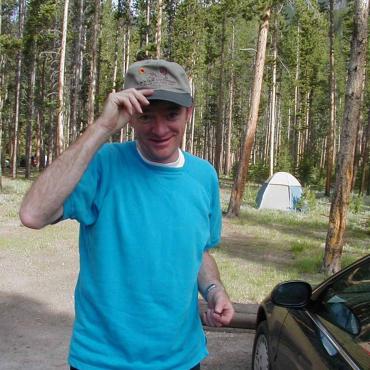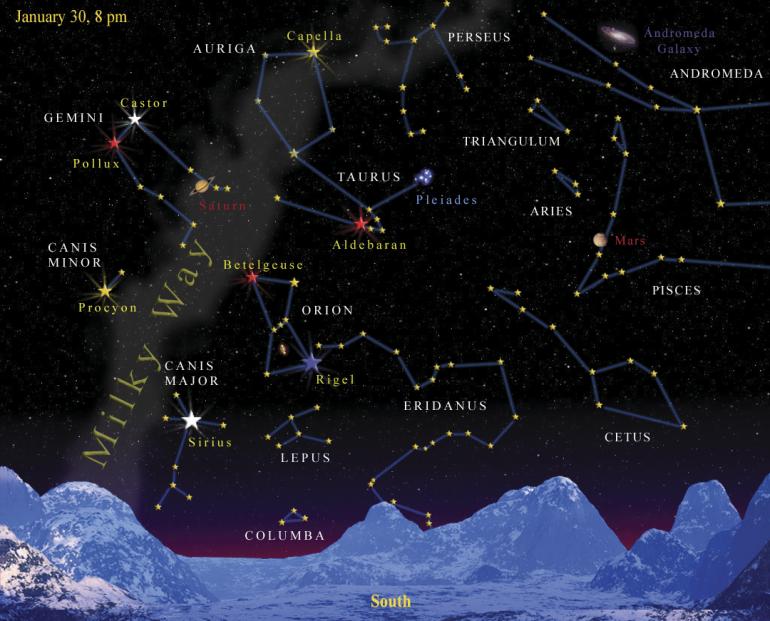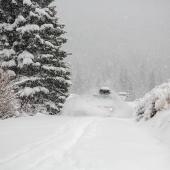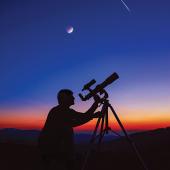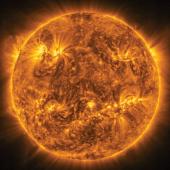Winter's Wild Bunch
Montana—in a normal winter—is nothing if not cold. Snow drapes the mountains like a powdery blanket, the air is sharp and brittle, and even the stars huddle together for warmth. Just look at the Pleiades and you’ll see what I mean.
The Pleiades, or “Seven Sisters,” sails high on the frigid evenings of winter. Look for it a little south of overhead about 10 pm at New Year’s; it reaches that pinnacle about 8 pm in late January, and about 6 pm in late February. Officially, it marks the beefy shoulder of Taurus the bull as he backs across the sky, apparently wary of the upraised club of Orion the hunter. But the Pleiades, made of fainter but distinctively-clustered stars, has always taken on a life of its own. Call them cold, or hungry, or just plain annoyed (as various cultures have), their assorted adventures in legend and lore earn them the title of “Wild Bunch” of the sky.
The Pleiades mark the brightest stars of a cluster of perhaps 500 members lying 380 light years away. By stellar standards, they’re mere striplings, having formed out of a cloud of gas and dust about 100 million years ago. At present, they travel through a dusty region of space, and long-exposure pictures reveal this dust as lovely blue veils draping the brightest stars as the dust reflects the stars’ hot blue light. The six brightest stars are readily visible in a dark sky to a good eye, but better eyes in darker skies can see seven and sometimes more. Binoculars show the cluster very nicely.
By mythological standards, these stars have been around the block and then some, having masqueraded as everything from a bunch of grapes in Rome to a hen and her bunch of chicks in Romania. But most often they’ve been regarded as a troupe of six or seven kids.
Among the Blackfeet Indians, the stars were six brothers who, upon failing to receive red buffalo calf robes in the spring like the other children, hotfooted it into the sky in a fit of pique and persuaded the sun and moon to withhold the rain from the people below. Drought ensued, and only when the people cried out for help did the sun and moon relent and send down showers to the Earth. But the six brothers remain in the sky—where, if five years of Rocky Mountain drought are any indication, they also remain capable of mischief.
The Onondaga Nation called this cluster the Seven Dancing Children, and tell a tale of how they were so fond of dancing that they never stopped to eat. At last the children became so lightheaded that they danced right up into the sky. Sometimes seven can been seen, and at other times only six when the youngest looks down and starts to cry, covering his face with his hands. But they can’t come down, and now they’re the Hungry Children, whose rising on late autumn evenings reminds those below of the coming of winter—and that they’d better hunt and gather and harvest lest they, too, become hungry when the snow grows deep.
But they’re most famous as the Seven Sisters of Greek mythology, the daughters of Atlas. One day they were spied at play by none other than the lusty Orion, who immediately became infatuated with them and approached for an introduction. The sisters, startled, fled instead, and that triggered the predator instinct in Orion who, like a grizzly bear, began to chase. The sisters cried out to the gods to save them, and the gods obliged by turning them into seven white doves who flew up into the sky beyond Orion’s grasp, and became the seven white stars clustered together that we see today.
But the chase wasn’t over. When Orion ultimately found his place in the heavens as well, he continued his pursuit of the sisters westward across the sky. So the gods grabbed Taurus the bull and placed him between the Seven Sisters and Orion, just to make sure that Orion never makes his catch. Go out on the next cold, clear night and there you’ll find them still: Orion, Taurus, and the Pleiades—the “Wild Bunch” twinkling together in the long, frigid dark of winter.
The Taylor Planetarium offers guided tours of the universe daily at the Museum of the Rockies, 600 W. Kagy Blvd., Bozeman, MT 59717, 406.994.2251.

